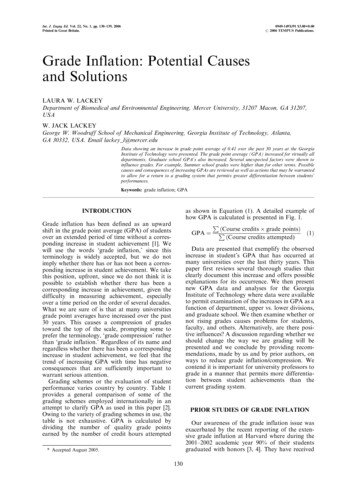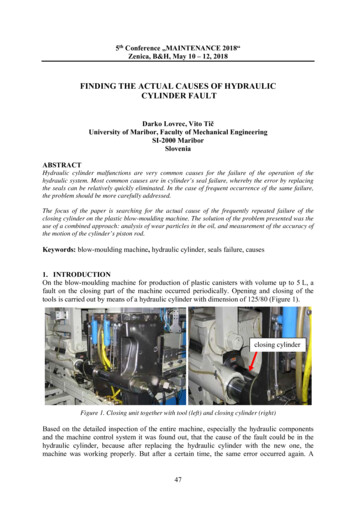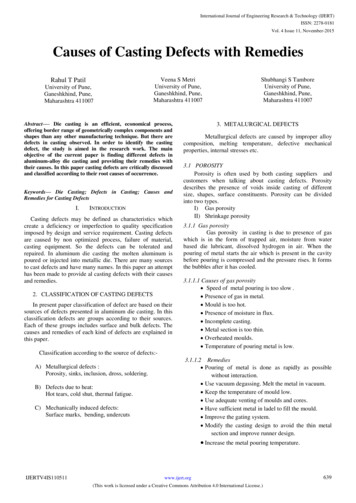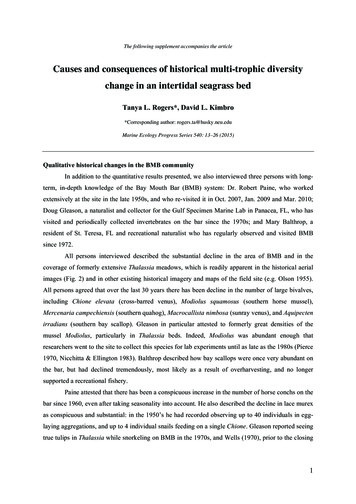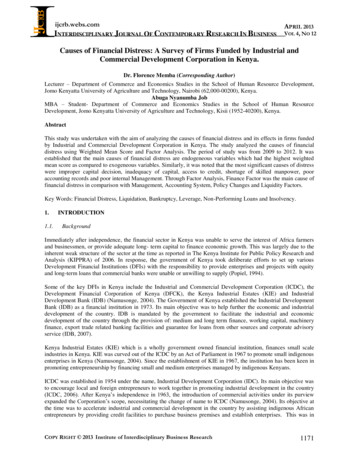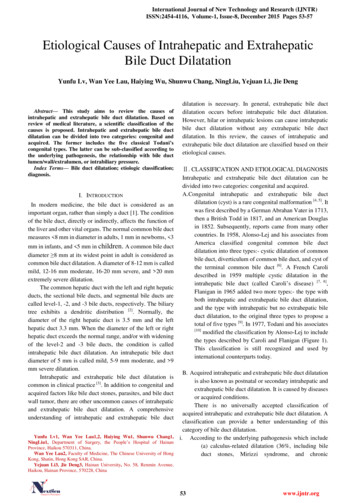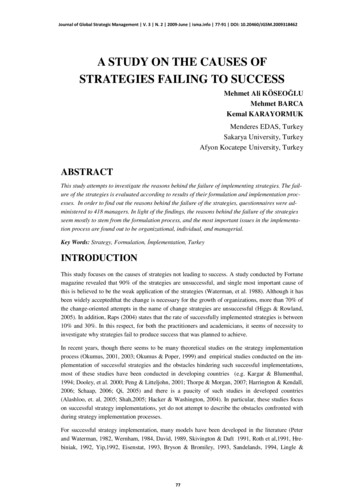
Transcription
Journal of Global Strategic Management V. 3 N. 2 2009-June isma.info 77-91 DOI: 10.20460/JGSM.2009318462A STUDY ON THE CAUSES OFSTRATEGIES FAILING TO SUCCESSMehmet Ali KÖSEO LUMehmet BARCAKemal KARAYORMUKMenderes EDAS, TurkeySakarya University, TurkeyAfyon Kocatepe University, TurkeyABSTRACTThis study attempts to investigate the reasons behind the failure of implementing strategies. The failure of the strategies is evaluated according to results of their formulation and implementation processes. In order to find out the reasons behind the failure of the strategies, questionnaires were administered to 418 managers. In light of the findings, the reasons behind the failure of the strategiesseem mostly to stem from the formulation process, and the most important issues in the implementation process are found out to be organizational, individual, and managerial.Key Words: Strategy, Formulation, mplementation, TurkeyINTRODUCTIONThis study focuses on the causes of strategies not leading to success. A study conducted by Fortunemagazine revealed that 90% of the strategies are unsuccessful, and single most important cause ofthis is believed to be the weak application of the strategies (Waterman, et al. 1988). Although it hasbeen widely acceptedthat the change is necessary for the growth of organizations, more than 70% ofthe change-oriented attempts in the name of change strategies are unsuccessful (Higgs & Rowland,2005). In addition, Raps (2004) states that the rate of successfully implemented strategies is between10% and 30%. In this respect, for both the practitioners and academicians, it seems of necessity toinvestigate why strategies fail to produce success that was planned to achieve.In recent years, though there seems to be many theoretical studies on the strategy implementationprocess (Okumus, 2001, 2003; Okumus & Poper, 1999) and empirical studies conducted on the implementation of successful strategies and the obstacles hindering such successful implementations,most of these studies have been conducted in developing countries (e.g. Kargar & Blumenthal,1994; Dooley, et al. 2000; Peng & Litteljohn, 2001; Thorpe & Morgan, 2007; Harrington & Kendall,2006; Schaap, 2006; Qi, 2005) and there is a paucity of such studies in developed countries(Alashloo, et. al, 2005; Shah,2005; Hacker & Washington, 2004). In particular, these studies focuson successful strategy implementations, yet do not attempt to describe the obstacles confronted withduring strategy implementation processes.For successful strategy implementation, many models have been developed in the literature (Peterand Waterman, 1982, Wernham, 1984, David, 1989, Skivington & Daft 1991, Roth et al,1991, Hrebiniak, 1992, Yip,1992, Eisenstat, 1993, Bryson & Bromiley, 1993, Sandelands, 1994, Lingle &77
Journal of Global Strategic Management V. 3 N. 2 2009-June isma.info 77-91 DOI: 10.20460/JGSM.2009318462Schieman, 1994, Okumus, 2001, Peng and Litteljohn,2001, Higgins, 2005). However, these modelsdo not clearly discuss the extent to which the factors allowing strategies to lead to success and/orfactors preventing strategies from resulting in success. That is, it has not yet been shed much light onwhether the strategic formulation process or strategy implementation process is more influential interms of strategies’ resulting in success or failure. Alashloo et al. (2005) attempt to categorize thereasons for the failure of strategies under four main headings: i) Planning Consequences, ii) Organizational Issues, iii) Managerial Issues, iv) Individual issues. However, they do not deal with thequestion of which of these categories is more influential on the success of strategies.In this respect, the main contribution of the present study is expected to determine the most influential factors preventing strategies from being successful, taking the four categories of factors(planning, organization, management, and individual) into account.To this end, we selected the sampling among the firms in Turkey. With the implementation of theconditions of the free market economy as of 1980, the companies in Turkey have become more liberal and more foreign investment has come to the country, which forced the organizations to adjustthemselves to emerging market conditions. These changes put Turkey among the 10 biggest developing markets. Another factor leading to the selection of sampling from Turkey is its unique culturaland historical texture. A bridge between the West and East, Turkey is a candidate country for European Union membership. These special characteristics of the country have important influences onthe strategies of the organizations developed to gain a competitive advantage. On the other hand,political and economic crises experienced in the country in the last ten years have a power to directthe orientation of the organizations in the country. Hence, it is believed that the investigation of theefforts of the organizations throughout this process will reveal important results for the purpose ofthe present study.Therefore, the sampling of the study consists of the managers of the organizations operating in Turkey. The questionnaire designed, which was based on the study by Alashloo, Castka and Sharp(2005) mentioned above, was administered to the top managers of the organizations selected regardless of their size.In what follows is that the study first looks at the causes behind the failure of strategies and focuseson the obstacles encountered in the processes of strategy formulation and strategy implementation.Here, given the theoretical discussion of the causes, the hypotheses to be tested are set. Then, theresults and findings of the study are discussed. In the final section suggestions for the future researchare made.Strategy ImplementationAlexander (1991) likens the strategic management process to a two-sided medallion. One side of themedallion is the strategy formulation describing the action plan that enables the organization to compete in specific situations; the other side represents the strategy implementation process describinghow the formulated strategy is implemented. Hence, it can be argued that whether a strategy is successful or unsuccessful depends separately on these processes and their interaction. Namely, workperformance is not only related to how well the strategies are formulated but also how well they areimplemented. Indeed, unless successfully applied, even the strategy delicately designed and correctlypredicted is almost valueless. While strategy formulation and application are functions closely connected to each other, implementation of the strategy is the most complex and time-consuming part ofstrategic management. Strategy implementation covers almost every aspect of the management and itneeds to be started from many different points within the organization (Shah, 2005). Though the78
Journal of Global Strategic Management V. 3 N. 2 2009-June isma.info 77-91 DOI: 10.20460/JGSM.2009318462reason for the failure of strategies is viewed to be strategy implementation process in the strategicmanagement literature, this issue has attracted less attention than the issue of strategic formulation inresearch (Webster, 1981, Kargar & Blumenthal, 1994). Alexander (1991) gives the reasons behindthis fact as follows: strategy implementation is less glamorous than strategy formulation; many academics and practitioners tend to overlook it because of a belief that anyone can do it; people are notexactly sure what strategic management process includes, where it begins and where it ends; thereare only a limited number of conceptual models of strategy implementation.According to Hrebiniak (2005) the formulation-implementation relationship is as such: "Still, it isobvious that the execution of strategy is not merely as clear and understood as the formulation ofstrategy. Much more is known about planning than doing, about strategy making than making strategy work". In general, in strategic management literature and in particular, in strategy literature,strategy implementation is viewed to be different from strategy formulation and it is considered to bean issue of adjusting organizational structures and systems (Aaltonen et. al 2002). Alashloo et. al.,(2005) defines strategy implementation as the explanation of how the strategy developed in a limitedtime should effectively be implemented to the capacities, human and financial resources of the organization. According to Reid (1989), strategy implementation is a vital process describing the opportunities of the future. From another viewpoint, strategy implementation is the collection of implementations and operations originating from the important managerial capabilities and behavioursdefined for good leadership (de Kluyver & Pearce, 2003). Shah (2005) defines strategy implementation as the implementation of strategy formulation to determine the future direction of the organization. Parnell (2008) explains strategy implementation through the concepts of participation, conception, and commitment that affect the dissemination of the strategy. As it can be seen in these definitions, strategy implementation is a complex process (Schellenberg, 1983).It is really difficult to come up with an exact definition of strategy implementation. Definitions ofstrategy implementation are shaped according to strategy formulation, elements of organizationalbehaviours and its importance for the organization. Another complex issue related to strategy implementation is concerned with the factors affecting strategy implementation. There are many differentopinions about this issue, which are presented in Table 1.When we evaluate the factors affecting strategy implementation, it is seen that successful implementation of strategies is of great importance for all the organizations either private or public. Even thebest strategies are useless unless they are applied well (Aaltonen et al 2002). In other words, strategy’ breeding success can only be achieved through implementation. The subtle point here is that nomatter how internally consistent is the strategic achievement concept, how many innovative elementshas it got, how strong the organization is positioned against the rivals by it, what is most concernedabout is how well it is implemented. And success of the implementation depends on the actors involved. For strategy implementation to be successful, Thompson et al (2006) proposed a 9-stagedprocess. These are:1. Staffing the organization with the needed skills and expertise, consciously building and strengthening strategy-supportive competencies and competitive capabilities, and organizing the workeffort.2. Creating a company culture and work climate conducive to successful strategy implementationand execution.3. Developing budgets that steer ample resources into those activities critical to strategic success.79
Journal of Global Strategic Management V. 3 N. 2 2009-June isma.info 77-91 DOI: 10.20460/JGSM.20093184624. Ensuring that policies and operating procedures facilitate rather than impede effective execution.5. Using the best-known practices to perform core business activities and pushing for continuousimprovement. Organization units have to periodically reassess how things are being done anddiligently pursue useful changes and improvements.6. Installing information and operating systems that enable company personnel to better carry outtheir strategic roles day in and day out.7. Motivating people to pursue the target objectives energetically and, if needed, modifying theirduties and job behavior to better fit the requirements of successful strategy execution.8. Tying rewards and incentives directly to the achievement of performance objectives and goodstrategy execution.9. Exerting the internal leadership needed to drive implementation forward and keep improving onhow the strategy is being executed. When stumbling blocks or weaknesses are encountered, management has to see that they are addressed and rectified on a timely basis.Table 1. Factors Influencing Strategy ImplementationAuthorsFactorsPeter and Waterman(1982) McKinsey’s 7SStructure, style, staff, shared values, skills, system, strategy.Wernham (1984)Resources, confidence, others delivering what they promised, information and back-up materialsDavid (1989)Motivation, leadership and direction skills, co-ordinationSkivington & Daft (1991)Intended strategy, structure, systems, interactions, sanctionsRoth et al (1991)Coordination, managerial philosophy, configuration, formalization,centralization, integrating mechanismsHrebiniak (1992)Leadership, facilitating global learning, developing global managers,having a matrix structure, working with external companiesYip (1992)Organizational structure, culture, people, managerial processesEisenstat (1993)Competence, co-ordination and commitmentBryson & Bromiley(1993)Context, process, outcomeSandelands (1994)Commitment, time, emotion and energyLingle & Schieman(1994)Market, people, finance, operation, adaptability, and environmentalfactorsOkumus (2001)Content, context, process, outcomePeng ve Litteljohn(2001)Structural arrangements and the selection and development of key rolesHiggins (2005)Strategy and purposes, structure, systems and processes, style of leadership, staff, resources, shared values, organizational culture, and strategicperformance.Birnbaum (2007)Action planning; organisational structure; human resources; the annualbusiness plan; monitoring and control; the linkage- The Foundation forEverything Else.80
Journal of Global Strategic Management V. 3 N. 2 2009-June isma.info 77-91 DOI: 10.20460/JGSM.2009318462Feo&Jansen (2001) suggest 10 steps for strategy implementation to be successful. These are: establish a vision, agree on a mission, develop key strategies, develop strategic goals, establish values,communicate company policies, provide top management leadership, deploy goals, measure process,review progress. Also according to Wheelen and Hunger (2006) the most important activities involved in strategy implementation are: (1) involving people from all organisational levels in strategyimplementation, i.e. allocating the responsibility for strategy execution; (2) developing programmes,budgets and procedures; (3) organising for strategy implementation; (4) staffing (matching the managers and employees with the strategy); and (5) leading by coaching people to use their abilities andskills most effectively and efficiently to achieve the organisational objectives.Obstacles in front of Strategy ImplementationThe most important reason for the failure of the organization is the obstacles encountered while implementing strategies. The literature presents many problems encountered while implementingstrategies (Okumuþ, 2001, Dobni, 2003, Dooley et al. 2000, Freedman, 2003, Beer & Eisenstant,2000, Hoag et al. 2002, Dobni, 2003, Galpin, 1998). For instance, Alexander (1991) mentions various reasons as obstacles: i) Implementation took more time than originally planned, ii) Unanticipatedmajor problems arose iii) Activities were ineffectively coordinated, iv) Competing activities andcrises took attention away from implementation, v) The involved employees had insufficient capabilities to perform their jobs, vi) Lower-level employees were inadequately trained, vii) Uncontrollable external environmental factors created problems, viii) Departmental managers provided inadequate leadership and direction, ix) Key implementation tasks and activities were poorly defined, x)The information system inadequately monitored activities. Wessel (1993) points out many individualbarriers hindering successful implementation of strategies such as, too many and conflicting priorities, insufficient top team functions, a top down management style, interfunctional conflicts, poorvertical communication and inadequate management development.Beer & Eisenstant (2000) see the barriers in front of strategy implementation as “six silent killers ofstrategy implementation” and explain them as follows: a top-down/laissez-faire senior managementstyle, unclear strategic intentions and conflicting priorities, an ineffective senior management team,poor vertical communication, week co-ordination across functions, business or borders, and inadequate down-the-line leadership skills development.Corboy & O’Corrbui (1999) define the obstacles as “deadly sins of strategy implementation” and goon explaining them as follows: a lack of understanding of how the strategy should be implemented,customers and staff not fully appreciating the strategy, unclear individual responsibilities in thechange process, difficulties and obstacles not acknowledge, recognized or acted upon, and ignoringthe day-to-day business imperatives.In addition, according to Giles (1991) there are three reasons why poor strategic planning is an obstacle to strategy implementation: i) a strategy is not really a strategy but "a mixture of budgets andmanagement wish list"; ii) a strategy is not executable; and 3) the executors do not accept the strategy as "their own" because they did not participate in its formulation.Alashloo et al. (2005) subsumes the obstacles in front of strategy implementation under four headings. These are planning consequences, organizational issues, managerial issues and individual issues. Furthermore, they delineate what each heading consists of (Table 2).81
Journal of Global Strategic Management V. 3 N. 2 2009-June isma.info 77-91 DOI: 10.20460/JGSM.2009318462Table 2. The Impeders of Strategy ImplementationNoImpedersNoImpedersPPlanning consequencesOOrganizational IssuesP1Lack of exact strategic planningO1Incompatible structure with the strategyP2Insufficient linking of the strategy to goals.O2Unsuitable resources allocationP3Time limitationO3Lack of adequate communicationP4Lack of consensus among decision makersO4Lack of effective co-ordinationP5Lack of identification of major problemsO5Lack of adequate information systemP6Lack of effective role formulatorsO6Incompatible organizational cultureP7Unsuitable training systemO7Competing activities among peopleP8Unclear regulation and executive policiesO8Competing activities among unitsP9Lack of choice of real strategyO9Unsuitable evaluation and controlsystemsP10Lack of a national attitude to strategyO10Unsuitable compensation systemO11Inadequate physical facilitiesO12Lack of increative systemMManagerial IssuesIIndividual issuesM1Unsuitable leadershipI1Lack of enough capabilities of employeesM2Lack of adequate organizational supportI2Resistance to change among peopleM3Lack of adequate manager commitmentI3Resistance to change among unitsM4Fear of insecurity among managersI4Fear of insecurity in the new territoryM5Political factors in regard to powerI5Lack of understanding of the strategyM6Unsuitable personnel managementI6Inadequate connection to the visionM7Uncontrollable factorsI7Lack of enough motivation of employeesM8Lack of enough motivation among the managersI8Lack of employee commitmentAlashloo et al.(2005) categorization seems to be not only very comprehensive but also very operational in order to find out the relative importance of the obstacles in the processes of strategy development and application. Therefore, the categorization is taken for granted for this study.HypothesesIn Taslak’ s (2004) study of 112 textile firms in Turkey, the reasons behind the failure of strategiesare sought, yet this study does not indicate whether strategy formulation or strategy implementationis more influential on the success of strategies. In addition in Turkey managers are more affiliatedwith strategy planning than strategy implementation and evaluation (Dinçer et. al 2006). Accordingto the literature review, following hypothesis and structural equity model was generated.82
Journal of Global Strategic Management V. 3 N. 2 2009-June isma.info 77-91 DOI: 10.2046
8. Tying rewards and incentives directly to the achievement of performance objectives and good strategy execution. 9. Exerting the internal leadership needed to drive implementation forward and keep improving on how the strategy is being executed.

